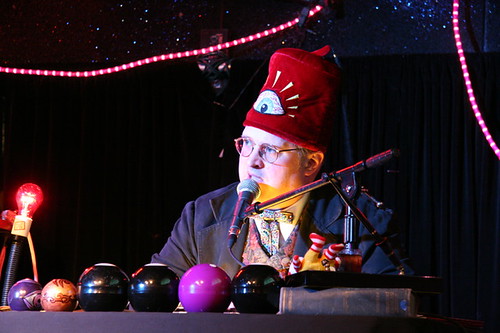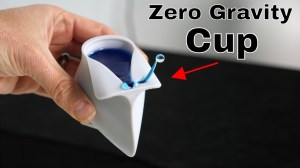photo by Scott Beale
Ok, this is it. Tonight’s installment of “Ask Dr. Hal”, “When Rhedosaurs call it quits! “, is the last Ask Dr. Hal ever at The Odeon Bar. As we mentioned yesterday, this is the final week of The Odeon Bar. The end. That’s all she wrote.
Here are my photos from last week’s epic show.
Tonight will be your last chance to ask Dr. Hal that question, the one question that has always been burning a hole in your mind. It doesn’t matter how absurd or trivial you may think your question might be, ask away. Hal will reward you will an answer that will exceed all your expectations. Hell, if the question is good enough, Chicken will even give you a shot of the coveted Fernet-Branca.
The final opening acts will be Nice Pants!, Robin Frohardt, Kelek, Ralph Carney and The Jelly Doughnut, the world’s largest and only rappin’ pastry.
The Last of the First Acts, a Huge, Animate Doughnut Takes the Stage! more carbohydrates and cholesterol than you have ever seen before in one place. He will “rap” on many topics, some not doughnut-related
Of course there will be Pete Goldie’s science report just prior to the show and David Capurro doing the Google images thing throughout the show. See you there!
Here are some of Hal’s favorite questions from previous shows:
“Dr. Hal, is there anything to Numerology?” (A Dr. Hal Classic)
Well, I’d probably use scientist Pete Goldie’s term to describe this particular superstition– “Malarkey.” Still, History abounds with curious numerical coincidences, and numbers phenomena have been of compelling interest to many in its pages. Take the case of composer Richard Wagner (1813-1883), who was haunted all his life by the number 13. There’re 13 letters in Wagner’s name, and the sum of the figures in the year of his birth were 13. He made his first public appearance in 1831, the numbers of which year– add ’em up– also come to 13. He completed his opera, Tannhauser, on April 13, and it was performed, in Paris, on March 13, 1861. Then on August 13, 1876, he began the first presentation of his epic masterwork the Ring of the Nibelungen. The year he was made Director of the State Theater at Riga, this theater opened on– September 13. Wagner wrote 13 operas in all, was exiled from Saxony for 13 years, and died, still fearing the number 13, on the 13th day of the month in the 13th year of the new German Confederation (the “Second Reich”). What does this all prove? Not much, in my opinion, when put up against all the other numbers in the composer’s life that didn’t add up to 13. But he wrote some pretty good operas, and his music even provided the inspiration for a Bugs Bunny cartoon, years later (“What’s Opera, Doc?” Warner Bros., dir. Chuck Jones, 1957). Yes, answering questions, that’s what it’s all been about… don’t knock it, it was a good gig…
“Dr. Hal, what’s the difference between a weasel and an ermine?” writes Anthony Phoer of San Francisco.
Thought you’d trick me, eh? Nice try. Yes, the weasel and the ermine are the same animal. This mammal’s coat changes with the seasons– in its white winter fur it’s an ermine, in its brown fur it’s just a plain old weasel. Like you, Tony.
“Dr. Hal, is rectal birth possible?”
Welll… yes. That’s right, there are recorded cases of babies that have been delivered ex fundamenti– that is, through the rectum. Sometimes, during a pregnancy, blockage of the mother’s vaginal orifice may occur, forcing the full-term fetus into the rectal area; the baby must then be expelled through the anus. A 19th century British doctor named Payne (appropriate, eh?) cites the case of a thirty-three-year-old woman who gave birth in this manner. Dr. Payne palpated the perineum, and seeing the child was located near the rectum, anesthetized the mother, a Mrs. N_____, and delivered the infant with forceps through the anal aperture “with little haemorrhage,” he writes, ” and an easy removal of the placenta.” And, Presto! A bouncing (if somewhat smelly) baby boy.
“Dr. Hal, what was the name of Alexander the Great’s horse?”
This was asked recently. The answer is, Bucephalus.
“Dr. Hal, is my ass too big?” writes Fan Ameke of San Francisco.
This query, often made, is not, strictly speaking, a “Dr. Hal question.” Yet its reiteration from many of my (female) acquaintances merits a reply here. In all cases to date the answer has been an emphatic “no.” An unrealistic standard, set by freakishly thin fashion models and non-heterosexual fashion designers has caused many normally formed girls and women to feel insecure about this essential element of their natural beauty. But if we travel through time to the wellsprings of our culture, we find that in Ancient Greece temples and statues were set up to Aphrodite Kallipygos, the “Goddess with the beautiful buttocks.” Within such an aesthesis, the robust is more classically favored than the gracile. Cercidias of Megalopolis recites in his Iambic verses the tale of the “fair-buttocked sisters of Syracuse.” Two beautiful girls, daughters of a farmer, argued over which of them had the more beautiful behind. To settle this, they both displayed themselves, bending over unclothed before a fair (and wealthy) youth who passed by. The latter was so struck by the charms of the elder sister that he went to bed ill; this prompted his younger brother to view both the fair contenders, whereupon he was smitten by the charms of the younger of the pair. So obsessed became the boys that at length their father arranged to have the girls joined in marriage to the two brothers. Pleased by this turn of events, as well as by their newly acquired splendid wealth, the sisters endowed the temple of Aphrodite, calling the goddess the “Fair-Buttocked” as related also by Archelaus. And they lived happily ever after. God bless you all.
UPDATE 1: My photos from the show are now online.
UPDATE 2: Jason did a write-up of the show for Metroblogging San Francisco. Unfortunately he didn’t quite make it to the actual Ask Dr. Hal part, which is understandable considering it didn’t start until around 11:30pm and went past closing time. Hal ended the show with a recitation of Samuel Taylor Coleridge’s “The Rhyme of the Ancient Mariner” as a reward for those who stuck it out until the very end.







